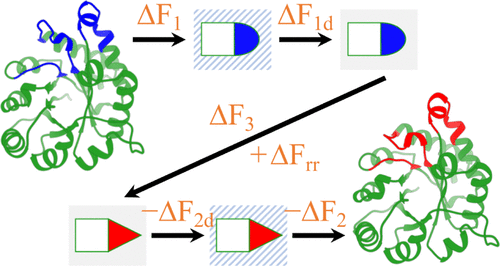当前位置:
X-MOL 学术
›
J. Chem. Theory Comput.
›
论文详情
Our official English website, www.x-mol.net, welcomes your
feedback! (Note: you will need to create a separate account there.)
Conformational Free-Energy Differences of Large Solvated Systems with the Focused Confinement Method.
Journal of Chemical Theory and Computation ( IF 5.7 ) Pub Date : 2020-06-19 , DOI: 10.1021/acs.jctc.0c00403 Paul B Orndorff 1 , Sang T Le Phan 1 , Ka Ho Li 1 , Arjan van der Vaart 1
Journal of Chemical Theory and Computation ( IF 5.7 ) Pub Date : 2020-06-19 , DOI: 10.1021/acs.jctc.0c00403 Paul B Orndorff 1 , Sang T Le Phan 1 , Ka Ho Li 1 , Arjan van der Vaart 1
Affiliation

|
The focused confinement method (FCM) is a reaction coordinate-free simulation approach for the calculation of conformational free-energy differences in explicit solvent. The method uses reference states for the conformations of interest, partitions the solute into conformationally active and inactive regions, and requires the calculation of desolvation free energies of mixed harmonic–anharmonic states as part of its procedure. The reference states and partitioning affect the speed of convergence of FCM’s constituent simulations in opposing manners, but in the thermodynamic limit, they have no effect on calculated conformational free-energy differences. To aid fast convergence of large systems, a general procedure to quickly partition and construct reference states is introduced. With this, two sets of reference states and associated partitionings were constructed for the closed and open conformation of triosephosphate isomerase (TIM). Despite TIM’s size, highly converged desolvation free energies were readily obtained from standard free-energy perturbation simulations because the mixed harmonic–anharmonic states are heavily rigidified. FCM-calculated free-energy differences for loop closing matched the experimental value for both reference sets. The insensitivity to reference states and associated partitionings favors reference states that merely reflect main structural differences for which convergence is faster. The calculations demonstrate the accuracy and robustness of FCM for large systems.
中文翻译:

集中约束法求解大型溶剂化体系的构象自由能差异。
聚焦限制方法(FCM)是一种无反应坐标的模拟方法,用于计算显式溶剂中的构象自由能差。该方法将参考状态用于感兴趣的构象,将溶质划分为构象有活性和无活性区域,并且需要计算其谐波-非谐混合态的去溶剂化自由能。参考状态和分区以相反的方式影响FCM组成模拟的收敛速度,但在热力学极限中,它们对计算的构象自由能差没有影响。为了帮助大型系统快速收敛,介绍了一种快速分区和构造参考状态的通用过程。有了这个,为磷酸三糖异构酶(TIM)的闭合和开放构象构建了两组参考状态和相关的分区。尽管TIM的尺寸很大,但由于标准的自由能扰动模拟已高度硬化,因此很容易从标准自由能扰动仿真中获得高度收敛的去溶剂化自由能。FCM计算的闭环自由能差与两个参考集的实验值均匹配。对参考状态和相关分区不敏感的情况倾向于使用仅反映主要结构差异(收敛速度更快)的参考状态。计算结果证明了FCM在大型系统中的准确性和鲁棒性。通过标准的自由能扰动模拟,可以很容易地获得高度收敛的去溶剂化自由能,这是因为高次谐波-非谐混合态被严格硬化了。FCM计算的闭环自由能差与两个参考集的实验值均匹配。对参考状态和相关分区不敏感的情况倾向于使用仅反映主要结构差异(收敛速度更快)的参考状态。计算结果证明了FCM在大型系统中的准确性和鲁棒性。通过标准的自由能扰动模拟,可以很容易地获得高度收敛的去溶剂化自由能,这是因为高次谐波-非谐混合态被严格硬化了。FCM计算的闭环自由能差与两个参考集的实验值均匹配。对参考状态和相关分区不敏感的情况倾向于使用仅反映主要结构差异(收敛速度更快)的参考状态。计算结果证明了FCM在大型系统中的准确性和鲁棒性。对参考状态和相关分区不敏感的情况倾向于使用仅反映主要结构差异(收敛速度更快)的参考状态。计算结果证明了FCM在大型系统中的准确性和鲁棒性。对参考状态和相关分区不敏感的情况倾向于使用仅反映主要结构差异(收敛速度更快)的参考状态。计算结果证明了FCM在大型系统中的准确性和鲁棒性。
更新日期:2020-08-11
中文翻译:

集中约束法求解大型溶剂化体系的构象自由能差异。
聚焦限制方法(FCM)是一种无反应坐标的模拟方法,用于计算显式溶剂中的构象自由能差。该方法将参考状态用于感兴趣的构象,将溶质划分为构象有活性和无活性区域,并且需要计算其谐波-非谐混合态的去溶剂化自由能。参考状态和分区以相反的方式影响FCM组成模拟的收敛速度,但在热力学极限中,它们对计算的构象自由能差没有影响。为了帮助大型系统快速收敛,介绍了一种快速分区和构造参考状态的通用过程。有了这个,为磷酸三糖异构酶(TIM)的闭合和开放构象构建了两组参考状态和相关的分区。尽管TIM的尺寸很大,但由于标准的自由能扰动模拟已高度硬化,因此很容易从标准自由能扰动仿真中获得高度收敛的去溶剂化自由能。FCM计算的闭环自由能差与两个参考集的实验值均匹配。对参考状态和相关分区不敏感的情况倾向于使用仅反映主要结构差异(收敛速度更快)的参考状态。计算结果证明了FCM在大型系统中的准确性和鲁棒性。通过标准的自由能扰动模拟,可以很容易地获得高度收敛的去溶剂化自由能,这是因为高次谐波-非谐混合态被严格硬化了。FCM计算的闭环自由能差与两个参考集的实验值均匹配。对参考状态和相关分区不敏感的情况倾向于使用仅反映主要结构差异(收敛速度更快)的参考状态。计算结果证明了FCM在大型系统中的准确性和鲁棒性。通过标准的自由能扰动模拟,可以很容易地获得高度收敛的去溶剂化自由能,这是因为高次谐波-非谐混合态被严格硬化了。FCM计算的闭环自由能差与两个参考集的实验值均匹配。对参考状态和相关分区不敏感的情况倾向于使用仅反映主要结构差异(收敛速度更快)的参考状态。计算结果证明了FCM在大型系统中的准确性和鲁棒性。对参考状态和相关分区不敏感的情况倾向于使用仅反映主要结构差异(收敛速度更快)的参考状态。计算结果证明了FCM在大型系统中的准确性和鲁棒性。对参考状态和相关分区不敏感的情况倾向于使用仅反映主要结构差异(收敛速度更快)的参考状态。计算结果证明了FCM在大型系统中的准确性和鲁棒性。










































 京公网安备 11010802027423号
京公网安备 11010802027423号